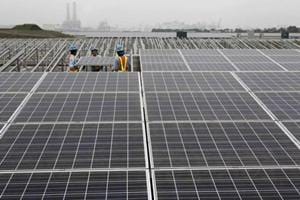In a two-decade-old paper titled ‘Renewable energy in the UK: the Cinderella sector transformed,’ author Gordon Walker—drawing an analogy with the fairy tale Cinderella—talked about how the renewable energy sector in the UK was neglected compared to fossil fuels and how it got transformed later on with the advances made. In India, too, the solar sector—on which there was minimal focus—is now becoming the cynosure of all eyes.
Solar energy got the required impetus with the launch of the Jawaharlal Nehru National Solar Mission, which set a target of 20,000MW of solar power by 2022. The mission, among other things, focuses on grid, off-grid applications, solar rooftops, solar lighting systems, etc. It also underscores the need for enhancing manufacturing capabilities of solar technology, strengthening R&D and a host of other policy measures that would make India a solar hub.
States, too, declared their policies. Gujarat became a model state; today it has 1GW of installed solar capacity, which is more than a quarter of India’s total. In fact, the 500MW Charanka solar park in the district of Patan is one of the largest in the world. The Renewable Purchase Obligation (RPO) regulation, which makes it obligatory on the part of distribution companies and captive power generators to have a specified percentage of renewable energy in the total power generated by them, is another measure which shows the commitment towards renewable energy.
Rooftop PV—also called RTPV, and installed on roofs of residential and commercial buildings—is receiving due attention. The International Energy Agency recognises the importance of solar energy in the power sector. In its ‘India Energy Outlook 2015’ report, it states that solar sector will witness dramatic growth, faster than any other source of generation. It predicts installed capacity to rise by 29GW in 2020 and 188GW by 2040, making India the second largest solar market in the world after China. This will boost the share of solar power in India’s total power capacity to 17% in 2040 from 1% today, the report adds.
Policy initiatives are encouraging and global reports point towards a bright future for solar. However, will policy initiatives bear fruit? The solar sector faces a few hurdles—land acquisition and evacuation, bankruptcy of global solar power companies, and the possible anti-competitive conduct in the future.
Land acquisition has always been the bane of power sector. UMPPs are one such example. Solar power generation is land-intensive—it needs huge tracts of land for installing transmission towers. The stalled 125MW projects in Parbhani and Osmanabad in Maharashtra are a case in point. The 24×7 power supply strategy report prepared by Forum of Regulators mentions that a major hurdle in the development of new transmission lines is the difficulty in obtaining additional Right of Way (RoW). To build transmission lines/sub-stations targeted in the 12th Plan, about 1.4 million acres of land is required. Resistance by farmers and landowners is resulting in cost overruns, which, in turn, would mean high cost of solar power. In fact, even the Charanka solar park had to face opposition from farmers.
Insolvency of international solar companies is another threat. The recent bankruptcy of SunEdison has set alarm bells ringing. A few months ago there was much euphoria about SunEdison establishing its footprint in India. It won a bid of R4.63kWh for a 500MW project in Andhra Pradesh. But then the company filed chapter 11 bankruptcy in the US. Such developments may make the lenders wary of advancing loans to solar power companies.
Then there is the possibility of anti-competitive conduct. An international case involving SolarCity, a company controlled by Elon Musk, and Arizona utility Salt River Project underscores the fear of anti-competitive conduct. The former has filed a lawsuit claiming that the latter is using anti-competitive practices to maintain monopoly around energy and solar power and unfairly block competition. It is ironical that, in another case, SolarCity is at the receiving end—Nevada consumers filed a suit against it, alleging that the rooftop solar installer omitted and failed to disclose information about the future rates before it installed panels on their homes. Similar developments cannot be ruled out in India.
However, if all policy measures are properly implemented and threats neutralised, then the solar sector can find its rightful place under the sun in India.
Rajesh Gangakhedkar is faculty, Department of Economics, and head, Infrastructure and Regulation Centre; RK Mishra is director, Institute of Public Enterprise, Hyderabad

